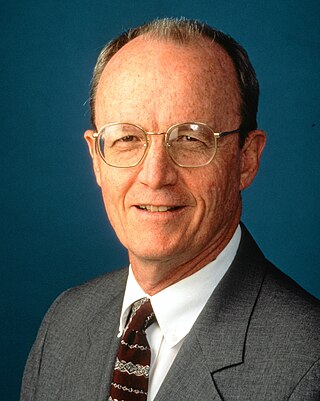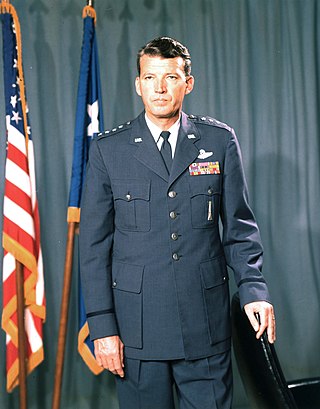Related Research Articles

Jet Propulsion Laboratory (JPL) is a federally funded research and development center in Pasadena, California, United States. Founded in 1936 by Caltech researchers, the laboratory is now owned and sponsored by the National Aeronautics and Space Administration (NASA) and administrated and managed by the California Institute of Technology.

Theodore von Kármán, was a Hungarian-American mathematician, aerospace engineer, and physicist who worked in aeronautics and astronautics. He was responsible for crucial advances in aerodynamics characterizing supersonic and hypersonic airflow. The human-defined threshold of outer space is named the "Kármán line" in recognition of his work. Kármán is regarded as an outstanding aerodynamic theoretician of the 20th century.
The MIT Lincoln Laboratory, located in Lexington, Massachusetts, is a United States Department of Defense federally funded research and development center chartered to apply advanced technology to problems of national security. Research and development activities focus on long-term technology development as well as rapid system prototyping and demonstration. Its core competencies are in sensors, integrated sensing, signal processing for information extraction, decision-making support, and communications. These efforts are aligned within ten mission areas. The laboratory also maintains several field sites around the world.
Ivan Alexander Getting was an American physicist and electrical engineer, credited with the development of the Global Positioning System (GPS). He was the co-leader of the research group which developed the SCR-584, an automatic microwave tracking fire-control system, which enabled M9 Gun Director directed anti-aircraft guns to destroy a significant percentage of the German V-1 flying bombs launched against London late in the Second World War.

The Electronic Systems Center was a product center of Air Force Materiel Command (AFMC) headquartered at Hanscom Air Force Base, Massachusetts. Its mission was to develop and acquire command and control, communications, computer, and intelligence systems. ESC consisted of professional teams specializing in engineering, computer science, and business management. The teams supervised the design, development, testing, production, and deployment of command and control systems. Two of ESC's most well-known developments were the Boeing E-3 Sentry Airborne Warning and Control System (AWACS), developed in the 1970s, and the Joint Surveillance Target Attack Radar System, developed in the 1980s.

Isaac Robert "Ike" Nassi, born 1949 in Brooklyn, New York, is the founder, and former CTO and chairman at TidalScale, Inc. before its acquisition by HPE, and an Adjunct Professor of Computer Science at the University of California, Santa Cruz. He is known for creating the highly influential Nassi–Shneiderman diagram notation. He also helped design the Ada programming language.
RDM may refer to:
The Aerospace Corporation is an American nonprofit corporation that operates a federally funded research and development center (FFRDC) in El Segundo, California. The corporation provides technical guidance and advice on all aspects of space missions to military, civil, and commercial customers. As the FFRDC for national-security space, Aerospace works closely with organizations such as the United States Space Force and the National Reconnaissance Office (NRO) to provide "objective technical analyses and assessments for space programs that serve the national interest". Although the USSF and NRO are the primary customers, Aerospace also performs work for civil agencies such as NASA and NOAA as well as international organizations and governments in the national interest.

Eberhardt Rechtin was an American systems engineer and respected authority in aerospace systems and systems architecture.

MIL-STD-810, U.S. Department of Defense Test Method Standard, Environmental Engineering Considerations and Laboratory Tests, is a United States Military Standard that emphasizes tailoring an equipment's environmental design and test limits to the conditions that it will experience throughout its service life, and establishing chamber test methods that replicate the effects of environments on the equipment rather than imitating the environments themselves. Although prepared specifically for U.S. military applications, the standard is often applied for commercial products as well.

Command and control is a "set of organizational and technical attributes and processes ... [that] employs human, physical, and information resources to solve problems and accomplish missions" to achieve the goals of an organization or enterprise, according to a 2015 definition by military scientists Marius Vassiliou, David S. Alberts, and Jonathan R. Agre. The term often refers to a military system.
ManTech International Corporation is an American defense contracting firm based in Herndon, Virginia. It was co-founded in 1968 by Franc Wertheimer and George J. Pedersen. The company uses technology to help government and industry clients. The company name "ManTech" is a portmanteau formed through the combination of "management" and "technology."

Dana Ulery is an American computer scientist and pioneer in scientific computing applications.

Edward K. Reedy was the director of the Georgia Tech Research Institute (GTRI) from 1998 to 2003, and correspondingly a vice president of the Georgia Institute of Technology. He first joined GTRI in 1970, and specialized in radar system development and electromagnetic scattering. Reedy held a variety of research and leadership positions within the organization, including the head of Research Operations and four years as associate director.

CNA, formerly known as the CNA Corporation, is a federally-funded nonprofit research and analysis organization based in Arlington County, Virginia. It has around 625 employees.

Larry E. Druffel is an American engineer, Director Emeritus and visiting scientist at the Software Engineering Institute (SEI) at Carnegie Mellon University. He has published over 40 professional papers/reports and authored a textbook. He is best known for leadership in: (1) bringing engineering discipline and supporting technology to software design and development, and (2) addressing network and software security risks.

Analytic Services Inc., better known by its acronym ANSER, is a not-for-profit corporation that provides services, largely to the U.S. federal government, in several mission areas. Its headquarters are in Falls Church, Virginia.

Gladys Mae West is an American mathematician. She is known for her contributions to mathematical modeling of the shape of the Earth, and her work on the development of satellite geodesy models, that were later incorporated into the Global Positioning System (GPS). West was inducted into the United States Air Force Hall of Fame in 2018. West was awarded the Webby Lifetime Achievement Award for the development of satellite geodesy models.

The United States Army Acquisition Corps (AAC) is the officer / NCO corps of the United States Army Acquisition Workforce (AAW), a branch which includes civilians, officers, and NCOs. The Acquisition Corps is composed of army officers who serve in acquisition, a specialized form of product development, fielding, and support and Noncommissioned Officers who specialize in Contracting, Level I Program Management and Purchasing. These officers begin their careers in the other branches of the army for eight years, after which they may elect the Acquisition branch as their career as assistant program managers (APMs), program managers (PMs), and program executive officers (PEOs). The Noncommissioned Officers (NCOs) are reclassified in the Army Acquisition NCO Corps after serving 7-10 years in their respective enlisted career management fields, and serve primarily in the Army Acquisition Career Management Field - 51 and (MOS) 51C. 4% percentage of the Army Acquisition Officers serve among the 40,000 members of the army acquisition workforce, 6% in MOS 51C - Acquisition, Logistics and Technology Contracting Noncommissioned Officer, and the remainder 90% percentage consist largely of Department of the Army civilians.

While the United States Space Force gained its independence on 20 December 2019, the history of the United States Space Force can be traced back to the beginnings of the military space program following the conclusion of the Second World War in 1945. Early military space development was begun within the United States Army Air Forces by General Henry H. Arnold, who identified space as a crucial military arena decades before the first spaceflight. Gaining its independence from the Army on 18 September 1947, the United States Air Force began development of military space and ballistic missile programs, while also competing with the United States Army and United States Navy for the space mission.
References
- ↑ “Rapid Development Speeds Command System Delivery” Signal Magazine, Armed Forces Communications and Electronics Association, Page 68, March 1995.
- ↑ L. Gref and W. Spuck, "The Rapid Development Methodology Applied to Software Intensive Projects", Eleventh Annual National Conference on Ada Technology
- ↑ "Ada and the rapid development lifecycle"; Deforrest, Lloyd; Gref, Lynn; NASA Center: Jet Propulsion Laboratory 1991; Accession Number: 92N22469; Document ID: 19920013226
- ↑ AD HOC Study "Knowledge Management" Army Science Board 2001 Nov 2001 Authors: John H. Reese; Christine B. Davis; James R. Fisher; Gary Glaser; Lynn G. Gref; William E. Howard III; David R. Martinez; Edward K. Reedy; Thomas Rogers; Stuart H. Starr; ARMY SCIENCE BOARD WASHINGTON DC
- ↑ "Prioritizing Army Space Needs"; Army Science Board Washington DC;
- ↑ "Naval Expeditionary Logistics: Enabling Operational Maneuver from the Sea" (1999) Commission on Physical Sciences, Mathematics, and Applications (CPSMA); The National Academies Press
- ↑ "The Navy and Marine Corps in Regional Conflict in the 21st Century" (1996) Commission on Physical Sciences, Mathematics, and Applications (CPSMA); The National Academies Press
- ↑ University of California, Riverside CNAS Board of Advisors Archived 2010-06-16 at the Wayback Machine
- ↑ Mathematics Genealogy Project;
- ↑ R. L.Chase and L. G. Gref, "MIRV Effectiveness Assessment"; Aerospace Technical Report
- ↑ G. Aubert and L. G. Gref, "Hard Point Defense System Effectiveness"; Aerospace Technical Report prepared for U.S. Air Force
- ↑ “An Assessment of Some Safeguards Evaluation Techniques – Final Report” Gref, L.G., Rosengren, J.W., Prepared for the U.S. Nuclear Regulatory Commission, 1997; NUREG 0141
- ↑ “Report to the Director of ARPA Concerning Applications of Packet Technology”; 1974; Gref, Lynn G., Kvitky, Joel S., Smith, H. P., Jr.; R&D Associates, RDA-TR-4300-013; Sponsored by Defense Advanced Research Projects Agency (DARPA)
- ↑ Kvitky, Wicks, Hoyt and Gref, "C3 For Overlay Defense of Minuteman" RDA Technical Report prepared for Department of Defense
- ↑ Contributor, "Computer Program Development Specification for the Distributed Command and Contro1 System, A and B Specifications"; RDA Technical Report prepared for U.S. Army
- ↑ Contributor, "Computer Program Development Specification for the Theater Automation Command and Control System -Korea, A and B Specifications"; RDA Technical Report prepared for U.S. Army
- ↑ "CNAS: CNAS Board of Advisors". Archived from the original on 2010-06-16. Retrieved 2010-10-10.
- ↑ "Giving to UCR: UCR Foundation Board of Trustees". Archived from the original on 2010-10-21. Retrieved 2010-10-10.
- ↑ "The Rise and Fall of American Technology"; Lynn G. Gref; Algora Publishing;
- ↑ http://www.stopamericasdecline.com Archived 2014-01-05 at the Wayback Machine